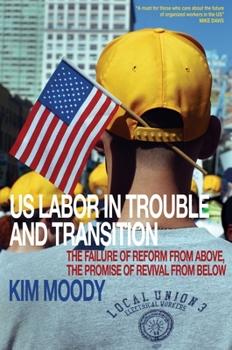Us Labor in Trouble and Transition: The Failure of Reform from Above, the Promise of Revival from Below
US Labor in Trouble and Transition tells the story of union decline in America and of the split in the labor movement it led to, following the dismal tale of union mergers and management partnerships... This description may be from another edition of this product.
Format:Paperback
Language:English
ISBN:1844671542
ISBN13:9781844671540
Release Date:September 2007
Publisher:Verso
Length:289 Pages
Weight:0.86 lbs.
Dimensions:0.8" x 6.3" x 9.2"
Customer Reviews
2 ratings
A careful look at the state of labor unions in the US
Published by Thriftbooks.com User , 14 years ago
A careful look at the available data reveals that many of the explanations commonly advanced for the decline in union power miss the root causes. Moody contends that, while neoliberal globalization has shipped some manufacturing outside the US, particularly in the textile and metal industries, the economy still rests very firmly on domestic production. Instead, Moody identifies spatial shifts within the US to southern states, changes in the composition of the working class, and a sustained campaign by capital to extort more from the workers, all of which the bureaucracy that dominate most of the unions were ill-equipped to respond to, as critical factors responsible for the decline of union power. He also contends that bureaucracy's willingness to make concessions, its opposition to rank-and-file militancy, and its authoritarian hierarchy have lead most unions to rely on "shallow power," such as contracts, labor-management cooperation schemes, and litigation to defend workers and mergers and acquisitions to increase density are largely responsible for the collapse of union organizing that reached a tipping point in the 1980-81 recession. Instead of an authoritarian hierarchy or a corporate business model, Moody proposes that unions be managed democratically, and that the emphasis be on providing workers with the resources and experience needed to become leaders themselves. To build a powerful labor movement that can reverse the balance of class forces in the US, Moody emphasizes the need to organize the southern states and to build class solidarity by extending beyond basic workplace organizing. It will most likely be the workers themselves, and not the union leaders, who offer the best hope of bringing the vision and the support needed to turn the next rise in class conflict into a lasting victory for the working class.
From analysis to action: some solid recommendations
Published by Thriftbooks.com User , 15 years ago
This book addresses two related matters. First, it provides a thoughtful and cleverly crafted analysis of the decline of the United States union movement. Second, it presents a strategy for union revival. The publication has 11 chapters which cover these issues from the perspectives of stakeholders in the labor management process. For example there are sections dealing with demographic and geographic changes; post-mortems on previous attempts to recreate more effective unions and, finally, a chapter which offers a comprehensive plan for their renewal. The book mostly has a historical focus. In this respect each discussion is inclined to make its point through presenting a contrast between industrial and post-industrial society. In making this contrast, the book stays focused on its key message(s). Moody presents argument(s) about union decline which are thoughtful, iconoclastic and embedded in a detailed discussion of economic history. In my opinion, the main strength of the book is that it provides a new and multidisciplinary way of understanding what happened to unions. It gives some convincing explanations of why the structures and institutions of post-industrial society are inherently less collective than the world in which I started my career. It replaces (or augments) views which vaguely imply that union demise is occurring because of: virtual workplaces, global trade and outsourcing. In this respect, the book breaks new ground through examining the antecedents of these phenomena and resists uncritically rehashing well rehearsed arguments. Rather, it offers a rather detailed narrative which posits that industry profits have declined in the post-OPEC years because of growing competition including international competition. Employers, so the argument goes, made up the shortfall through employment relations strategies. Broadly speaking, these have been: outsourcing; adoption of what we all know as the HRM approach; and lean manufacturing, which is perhaps a specific manifestation of HRM. For the most part, this argument is well supported by data from disparate sources. One of the book's strengths is that it incorporates an historical perspective into its argument. This approach has two advantages. First, and most importantly, it makes the work entertaining to those of us who are history buffs. I also enjoyed the way the author builds his case through moving back and forth between qualitative and quantitative consideration of various evidences. For example, the discussion of CEO salary growth is amongst the best analyses of this issue that I have seen. It incorporates information about aggregate trends as well as elements of case studies. Second, the book's argument(s) mostly have "face-validity"; they seem to arise from, or fit with, historical circumstances and appear to be supported by data. I have three criticisms of the book. First, on several occasions points are not explained as well as I think they need to be. There are two subcompo






